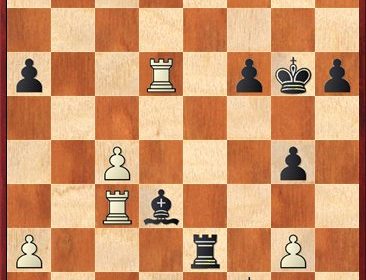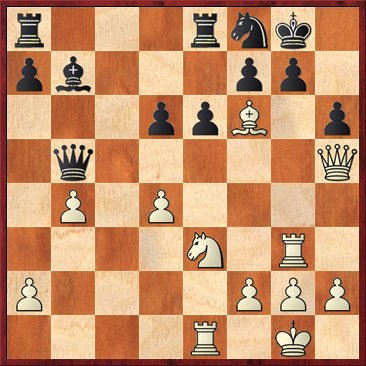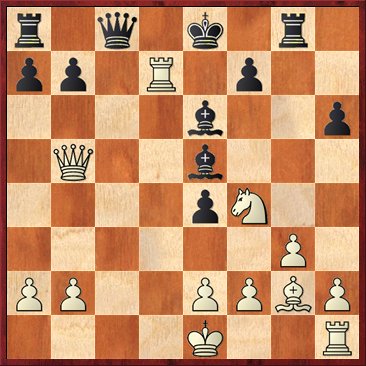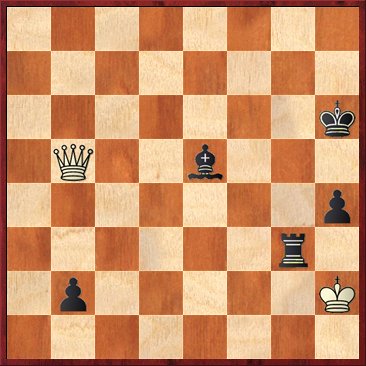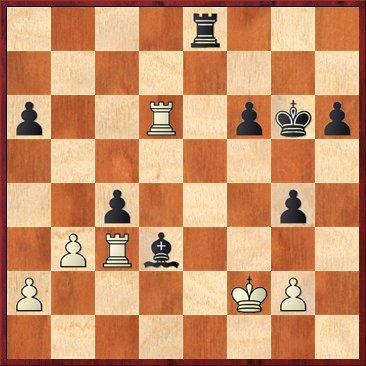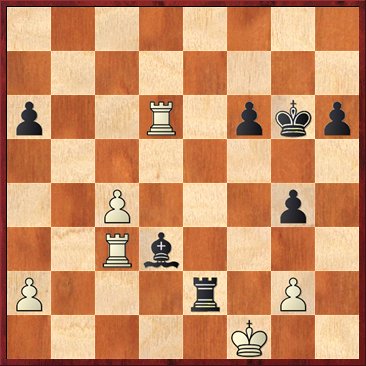by Ken Jones
After studying a number of his games, I found it interesting that a world-class player like Keres would occasionally play the Wing Gambit against the Sicilian. True, he made no claim of its soundness, but used it as a surprise weapon with the knowledge that Black would have to work out its details while the clock was ticking. It was also a psychological choice against opponents who had well-constructed opening repertoires. Off the board, though, my review of these games reveal more promising lines for Black than for White.
1. e4 c5 2. Nf3
Keres used the immediate 2. b4 only one time (against V. Vulberg, 1935 Estonian Ch.) After 2…cxb4 3. a3 e6 4. axb4 Bxb4 5. c3 Bf8 6. d4 d5 7. e5 we have reached a position that may also arise from a topical gambit line against the French (1. e4 e6 2. Nf3 d5 3. e5 c5 4. b4 cxb4 5. a3, etc.) Keres eventually won on time in a completely lost position, and thereafter preferred to delay the gambit.
2…d6
The O’Kelly variation 2…a6 can also be “winged”: 3. b4 cxb4 4. a3 d5?! (this central reaction is simply mistaken here, as Black does not even get a pawn for his troubles) 5. exd5 Qxd5? 6. axb4 Bg4 7. Nc3 Qh5? (misplacing the Q; Black should probably bail out with 7…Qe6+ as 7…Bxf3? loses material by 8. Nxd5 Bxd1 9. Nc7+ Kd8 10. Nxa8 and the N can escape via b6) 8. Be2 e6 9. 0-0 (The immediate 9. Ra5! also embarrasses the Q) Nf6 10. Ra5 Nd5 11. h3 (11. Nxd5 exd5 12. Re1 Be7 13. c4 also looks logical and strong to me) Bxf3 12. Bxf3 Nxc3 13. dxc3 Qg6 14. Qd4 (Black’s position is hopeless) Qf6 15. Qc4 Nd7 16. Bg5 Qg6 17. Bxb7 Rb8 18. Bc6 Be7 19. Bxd7+ Kxd7 20. Rd1+ Ke8 21. Qc7 (1-0), Keres-T. Gauffin, Helsinki 1935.
3. b4 cxb4
Rather than accept the pawn, Black will often play 3…Nf6, but Keres himself wryly noted that the gambit would be seen much more in international tournaments if this were the best reply! Still, there is nothing wrong with Black’s game after 4. bxc5 Nxe4 5. cxd6 Nxd6 6. Na3 Nc6. In actual practice vs Keres, though, Black reacted weakly: 6…Qa5?! 7. Nc4 Nxc4 8. Bxc4 e6 9.0-0 (Keres-J. Turn, Tallinn 1937) and 6…Qc7?! 7. Bb2 Bg4 8. Be2 Nd7 9. 0-0 Nf6 10. c4 (Keres-S. Herseth, Stockholm 1937). In both cases White has an edge in development, central control and plenty of open lines.
4. d4 Nf6
4…g6 (Keres noted that the fianchetto is logical) 5. Bb5+?! Bd7 6. Bc4 Qc8?! (White’s experimental approach provoked an awkward response; the obvious …Nc6 is better) 7. Nbd2 Bg7 8. 0-0 Nf6 9. e5 dxe5 10. dxe5 Ng4 11. Qe2 0-0 (again, 11…Nc6 12. Bb2 Qc7 gets pieces on better squares) 12. h3 Nh6 13. a3 (finally making it a real gambit) Nc6 14. axb4 Nxb4 15. Rb1 Nc6 16. Ba3 Nf5 17. Qe4 Be6?! (the anticipated misplay) 18. Bxe6 Qxe6? 19. g4 Nh6 20. Rxb7 Nxe5 21. Rxe7 Nxf3+ 22. Qxf3 (White regained the pawn with a slight edge due to the stranded Nh6) Qf6 23. Qe2 Rfd8 24. Ne4 Qc6 25. Re1 Bf8? (“winning” the exchange leaves his K-side fatally weak) 26. Qf3 Bxe7?? 27. Rxe7 (threatening the Queen by Nf6+) Rdc8 28. Qf4 (1-0), Keres-I. Dyner, Ostend 1937.
5. Bd3
5. Nbd2 Nc6 6. Bb2 e6 (This is a common set-up against the gambit. Black keeps the small center (pawns on d6 & e6) and develops behind it, hoping to get his King safe before trying to use the extra pawn. White will also not rush forward, but try to put his pieces on good squares while playing around the pawn on b4) 7. Bd3 Be7 8. 0-0 0-0 9. Qe2 Ne8 (the immediate 9…d5 10. e5 Nd7 is possible, when Black can later play …Re8 & …Nf8 to guard the K) 10. Rfe1 d5 11. Qe3?! (inching toward the K-side, but too slow) a6 12. Qf4 Qc7 13. e5 f5! (Using a tactic to close the position. Black’s King is now safe enough) 14. h4 Nd8?? (14…Nf6! heading to e4 gives Black the better game) 15. Rac1 Nf7? (now 15…Nf6!? could be met by 16. exf6 Qxf4 17. fxe7 Re8 18. exd8/Q Rxd8 which is unclear; materially, Black is doing fine but White’s total control of the dark squares should not be underestimated) 16. c4 bxc3 17. Rxc3 (as often happens with gambits, Black has kept the extra pawn but is behind in development and is passively placed, with plenty of weak squares to guard) Qd8 18. Ba3! (securing domination of the dark squares–which Black’s next move further weakens) g6? 19. Bxe7 Qxe7 20. Rb1 (with Black’s King hard to get at, White turns his attention to the other side of the board) Ng7 21. Nb3 Nd8 22. Nc5 b5 23. a4 Nh5? (this only chases the Queen to where the action is) 24. Qc1! Rf7 (now 24…bxa4 25. Nxa4 is ruinous) 25. axb5 a5? (25…axb5 is no fun, but to let White keep the pawn loses quickly) 26. Ng5 Rg7 27. b6 h6 28. Nf3 g5 29. hxg5 hxg5 30. Na4 Bd7 31. b7 Rb8 32. Rc8 Nf4 33. Rxb8 Nxd3 34. Qc7 (1-0), Keres-R. Bruno, Havana 1960.
5…d5!?
Perhaps this is why Keres waited until Black played 2…d6 to offer the gambit–striking in the center now costs Black a tempo. In a rare appearance of the Wing Gambit in modern grandmaster play, 5…g6 was played was seen in Timur Gareev-Gata Kamsky, 2015 US Ch. After 6. a3 bxa3 7. 0-0 Bg7 8. h3 0-0 9. Bg5 Nc6 10. Nc3 Nd7 11. Nd5 h6 12. Bh4 Nb6 (12…g5!?) 13. c3 Bd7 (13…Be6!?) 14. Rxa3, White had enough for the pawn. The game was drawn in 46 moves after a hard-fought struggle.
6. Nbd2 dxe4
6…e6 7. e5 Nfd7 8. 0-0 Nc6 is another way to play it, when White should try to get control of the dark squares by 9. a3.
7. Nxe4
For the rest of this game, I will make liberal use of Keres’ comments mixed in with my own observations.
7…Nbd7
7…Nxe4 8. Bxe4 Nd7 9. c4! Nf6 (9…bxc3 10. Qb3, Keres) 10. Bc2 (with initiative, Keres) e6 11. 0-0 Be7 (S. Buchal-H. Freise, Menden 1974) when both 12. a3!? or 12.Qd3!? give active play.
8. Neg5
Here, too, 8. c4 bxc3 9. Qb3 would lead to lively and interesting play (Keres), while simply 9. Nxc3 also gives adequate compensation.
8…Qc7
8…h6 9. Ne6 Qb6 10. Nxf8 followed by 11. 0-0 (Keres).
9. c4
Since the game continuation eventually gives Black the advantage, I suggest the simple 9. 0-0 e6 10. Re1, with compensation for the pawn.
9…h6
Keres implied that 9…bxc3 10. Qb3 e6 11. Nxf7! was good for White, but the computer now continues 11…Nc5! 12. dxc5 Kxf7 13. Qxc3 Qxc5 when Black is at least equal.
10. Nh3 g5
“No bad move” (Keres); my computer thinks more highly of it than that! To the modern eye, it seems like typical active defense, ignoring positional weakness to gain an initiative.
11. Nhg1
Given an ! by Keres, who noted that the N that started out on b1 now resides on the other N’s home square! He considers White’s position “more or less satisfactory”, which is somewhat generous.
11…Bg7 12. Ne2 e5 13. Ng3 0-0 14. 0-0 e4?
A mistake, although given an ! by Keres. Better is 14…Re8! 15. Re1 exd4 16. Nxd4 Ne5 giving Black a large advantage (Fritz); 14…exd4 15. h4! g4 16. Nxd4 is suggested by Keres without evaluation, but again Fritz prefers Black.
15. Nxe4 Nxe4 16. Bxe4 Qxc4 17. Bd3 Qd5 18. Re1 g4 19. Nh4 Nb6!?
A practical choice. Black faces a stiff attack after 19…Qxd4 20. Nf5 Qxa1 21. Qxg4, but he can survive with 21…Kh8! (Black gets mated after 21…Nc5 22. Nxh6+ Kh8 23. Qh5 [Euwe], or 21…Qf6 22. Bxh6 Ne5 23. Ne7+ Kh8 24. Bxg7+ Kxg7 25. Qh5+) 22. Nxh6 Qc3! (22…Bxh6 23. Qh4 Kg8! 24. Qxh6 Qg7 25. Qh4! [Keres] with a winning attack a Rook down) 23. Nxf7+ (White also forces a draw after 23. Nf5 Qxe1+ 24. Bf1 Qe5 25. Bb2 Bf6 26. Qh5+) Rxf7 24. Qh4+ Kg8 25. Bh7+ Kh8 (…Kf8?? 26 Qd8 mate).
20. Rb1 Bd7 21. Re4?
Better is 21. Rxb4 and White would not be worse (Keres).
21…Rfe8 22. Rf4 Qd6?
Keres gave 22…Na4! 23. Bd2! Nc3 24. Bxc3 bxc3 25. Bc2!, but the silicon solution Qxa2!! 26. Bb3 Qd2 just wins for Black, as do the alternatives 22…Qxa2 & 22…a5.
23. Bd2 Nd5 24. Rxg4! Bxg4??
Once again, the strain of constant defense proves too great. Black could hold the balance after 24…Nc3 25. Bxc3 bxc3 26. Nf5 Bxf5 27. Bxf5.
25. Qxg4 Qf6 26. Nf5 Kf8 27. Nxg7!
Once White has eliminated the strong defensive Bishop of his opponent, he soon obtains a decisive attack (Keres). There is little add to that.
27…Qxg7 28. Qh5 Nf6 29. Qh4 h5 30. Rxb4 Rac8 31. h3! Rc7 32. Rb5 Re6 33. Rxh5 (1-0), Keres-E. Eliskases, Semmering 1937.

